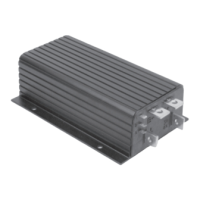12
Curtis PMC 1204/1205 Manual
contacts is added on the forward/reverse switch. Therefore, a double-pole,
double-throw (DPDT) center-off switch must be used for this setup. A
“hesitation switch” is recommended, to ensure the switch is in neutral
long enough to actuate HPD and inhibit plug braking.
Plug braking can be reactivated during freewheeling by releasing the
throttle and reapplying it.
Forward/Reverse Wiring (with alternate power wiring)
The basic wiring scheme in Figure 6 shows reversing via two single-pole,
double-throw (2×SPDT) contactors. Your vehicle may be configured for
a different type of reversing. Two alternative power wiring schemes are
described below—reversing with four single-pole, single-throw (4×SPST)
contactors, and reversing mechanically rather than electrically.
Power wiring for reversing with 4
×
SPST contactors
It is possible to use four single-pole, single-throw (4×SPST) contactors,
wired as shown in Figure 8. However, this configuration has the disadvan-
tage that if any one of the contactors sticks closed, the motor field is
effectively shorted out in one drive direction. The motor will not turn, and
it may be damaged if operated like this for long.
Other disadvantages are that four, rather than two, contactors must
be mounted and wired, and that the coils draw twice as much power. The
control wiring options for the 4×SPST contactors are the same as for the
2×SPDT contactors (see Figures 6 and 7).
As previously noted in the section on standard power wiring, when
using the Curtis PMC controller it is essential that the field be
reversed and that the armature be connected directly to the controller’s
B+ and A2 terminals, because the plug diode inside is connected to
these terminals.
Fig. 8 Power wiring
for reversing with
4
×
SPST contactors.
WIRING
MAIN
PRECHARGE RESISTOR
(250 Ω, 5 W)
FUSE
B-
B+
M-
A2
F
R
S2S1
R
F
+
–
A2
A1

